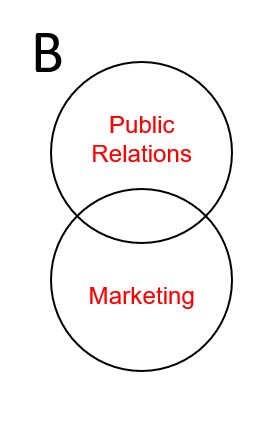PR and Marketing (2): Bits Overlapping

In the second model, the two are still mostly separate in functional terms. However, a small proportion of the workload is describable as both PR and Marketing – a good example would be advertising, especially advertising as an element of a multi-channel campaign involving a celebrity.
This model indicates that management consider the two functions as generally separable. Only a small number of jobs require collaboration. Those jobs maybe regular, i.e. identifiable as a set category of jobs, but never constitute a quantity sufficient to dominate the workload of either function. The activities that require cross-functional working are so few and in commercial terms so trivial, all but this (and possibly the “Apart” model) are invalid. Thus, the separation of the two functions remains. The separation generates efficiencies that facilitate the company’s strategy.
Essentially, this model differs from the A (“Apart” or “Silo”) model in only subtle ways. It is likely that the B model is temporary, forming only as and when required. When the requirement ceases, the two functions revert to their silos. Thus, for formal, organisational purposes, the silo model persists. The B (“Bits Overlapping”) model is more improvisation-according-to-need than organised.
In organisations that operate such a model, specialists are likely valued more highly than generalists. In place of a marketing-PR generalist, occasionally cross-functioning specialists interact when the requirement arises. In such a company, typically the scale of these functions will be uneven. Either marketing or PR will be larger and busier, but occasions for dual working will occur.
In terms of strengths, this model possesses the advantages of A (the “Apart” or “Silo” model) while also featuring adaptive flexibility. Workers in each department are familiar with and therefore capable of cross-functional working on specific jobs.
